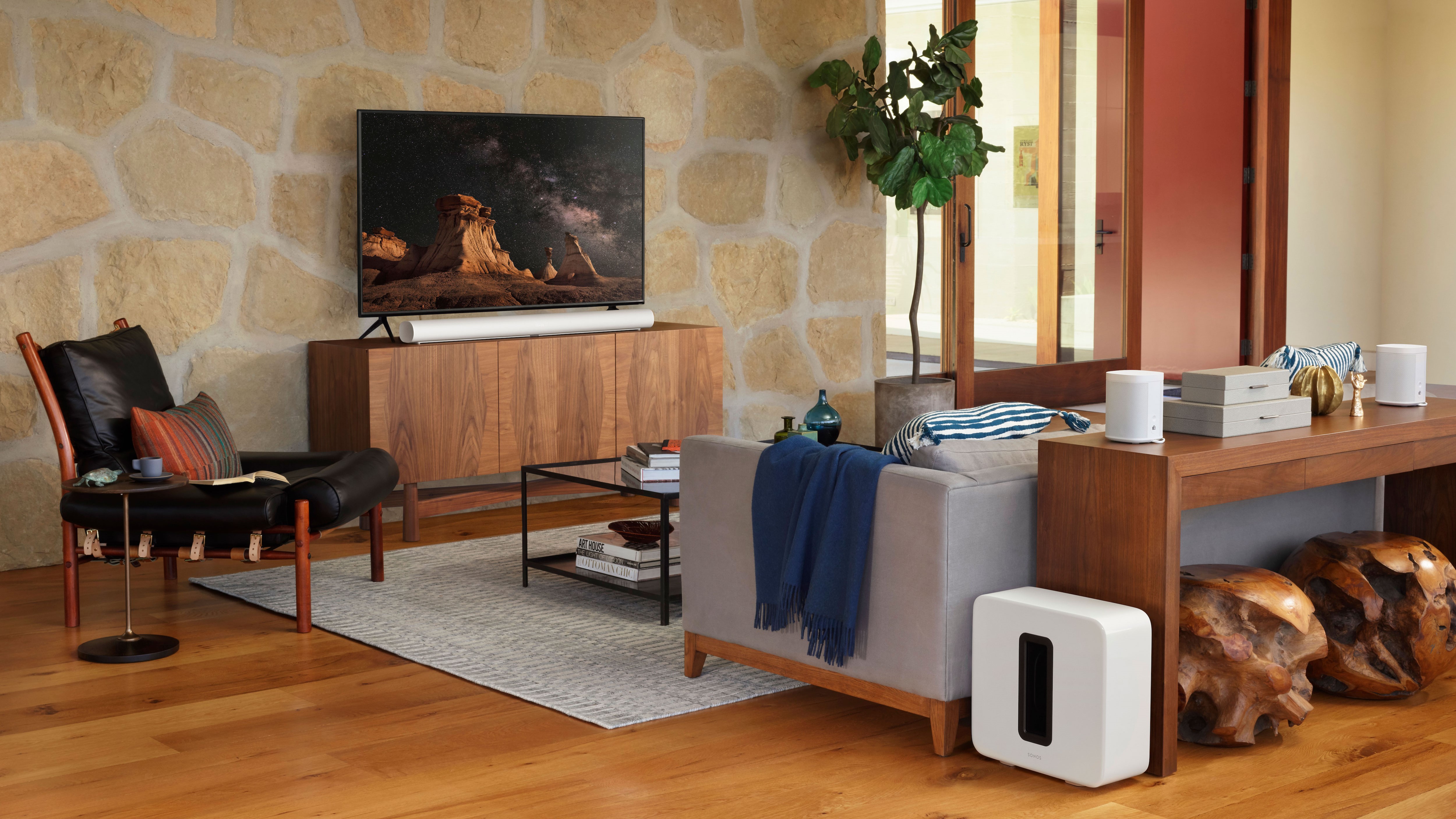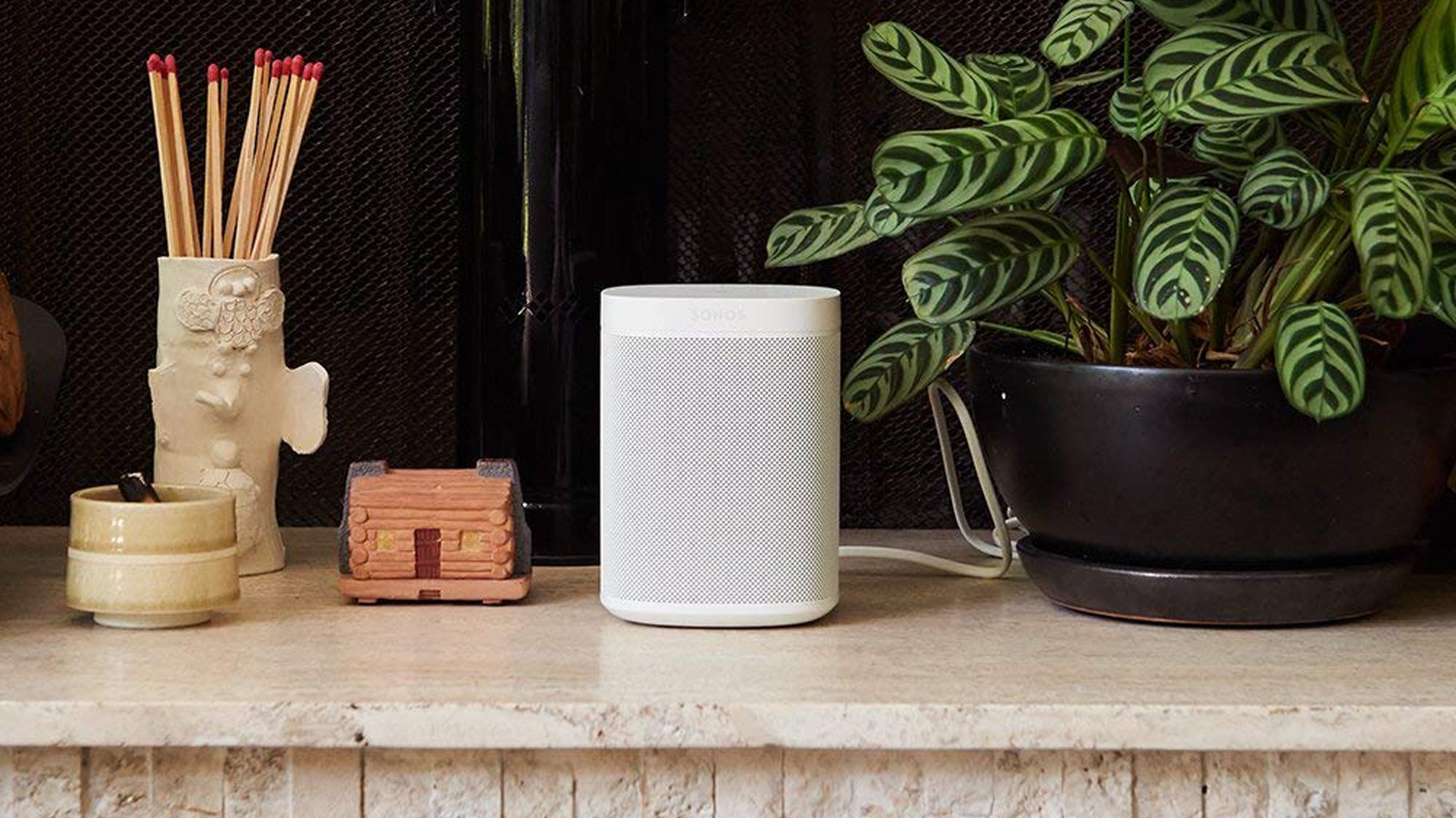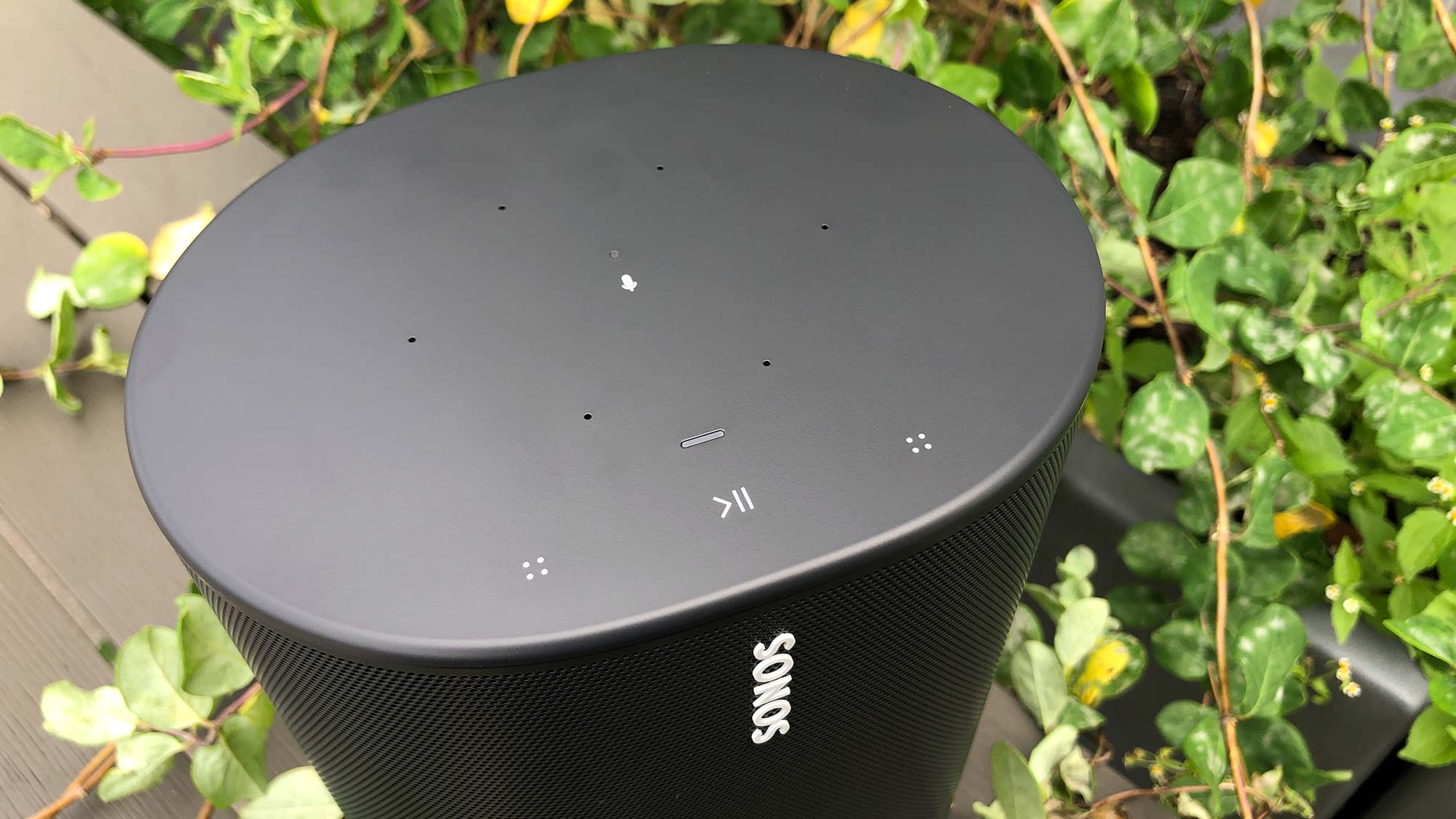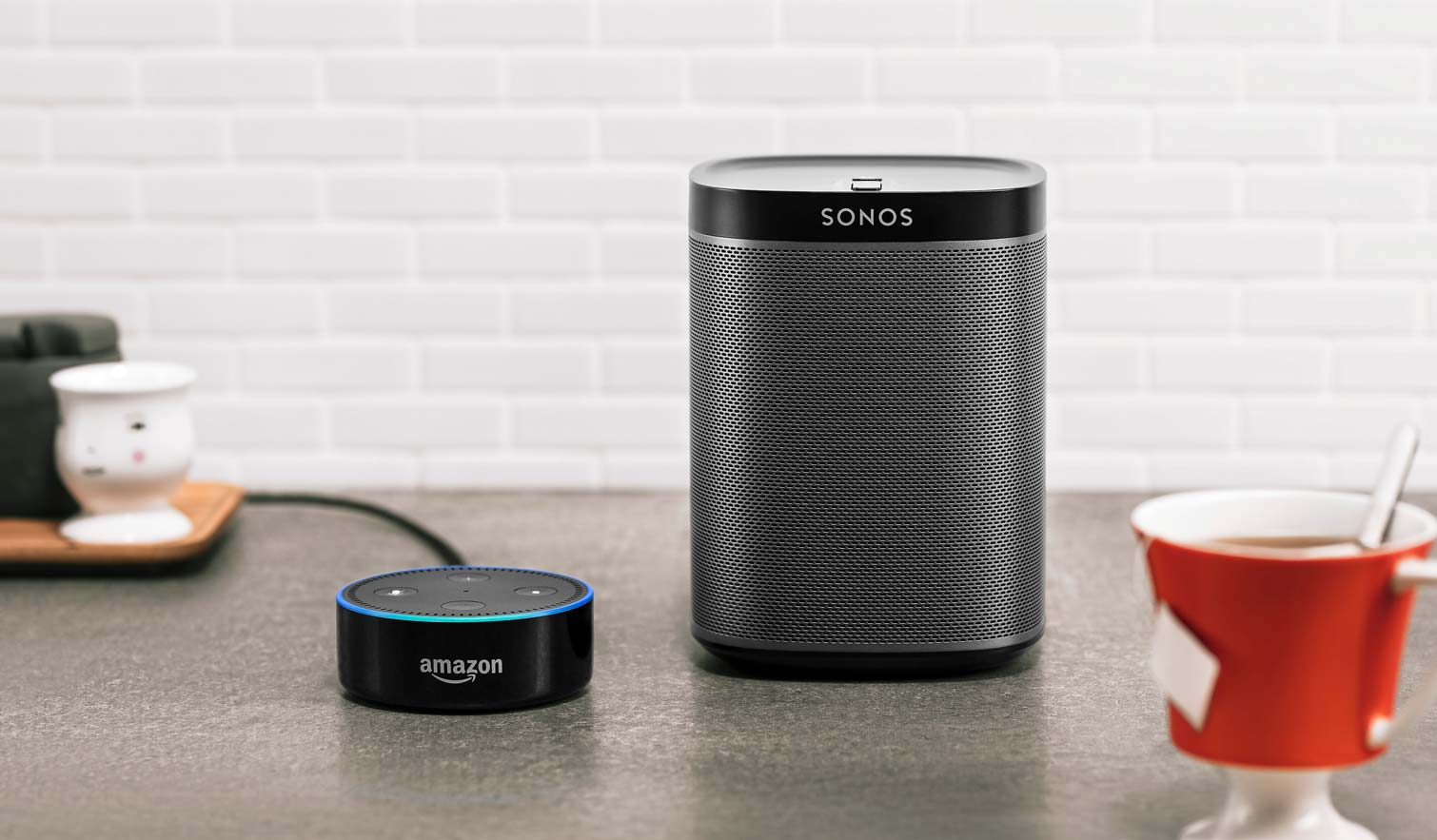What is Sonos? How the premium speakers work
Sonos audio devices are known for multiroom music playback, smart assistants, and support for all the major streaming services. Here's your guide to Sonos speakers.

Sonos' new Era 100 and Era 300 smart speakers have officially been unveiled. Buyers can preorder now via the Sonos website and both models go on sale on March 28. The Era 100 is pitched as the successor to the Sonos One, while the Era 300 is a radical new design with spatial audio support. Both models look set to rival some of the best smart speakers out there. Discover everything we know about the Sonos Era 100 and Era 300 from our hands-on first impressions, and how the Sonos Era 100 compares to the Sonos One.
What is Sonos, you might ask? Sonos is a leader in home audio and offers high-quality speakers that can stream premium sound around your home.
What makes Sonos stand out is its expansive streaming library. It supports everything from Spotify, Pandora and Tidal to Audible, Stitcher, and SiriusXM. You can find the best music apps, best audiobook apps and best best podcast apps on Sonos, but that's not all.
(Already have a Sonos setup? You can check out our top tips on how to get more from your Sonos system setup).
Sonos also has it's own streaming service called Sonos Radio, a free, ad-supported streaming radio experience that brings 60,000 global stations to your sound system. Unlike algorithm-based radio apps, the Sonos Radio lineup is handpicked by a team of curators, DJs and artists.
The Sonos experience relies heavily on its app, called Sonos S2, which launched with a refreshed interface and support for new devices alongside our Sonos Arc review two years ago. Sonos has been big intro expanding its soundbar offerings, releasing the Sonos Beam (Gen 2) in 2021 and coming out with the Sonos Ray in 2022.

Sonos speakers can go outside the home, too. As you'll read in our Sonos Roam review, the Roam is Sonos's first ultra-portable (and most affordable) speaker. See our Sonos Roam vs. Sonos Move face-off for more on how these two speakers differ.
Sonos is also the company that, in many ways, has perfected the whole-home audio experience. It supports the ability to play different tracks in various parts of the home, sync them together and control them all from your phone. Using the Sonos Voice Assistant or other third-party voice assistant platforms (Alexa and Google Assistant) you can even control your Sonos system hands-free.
Simply put, Sonos gives customers choices of high-end audio and a range of sleek speakers that can fit in just about any room. Here's how it all works.

Sonos Arc vs. Sonos Beam (Gen 2) vs. Sonos Ray soundbars
Why you can trust Tom's Guide
The Sonos Arc is the company's massive soundbar with Dolby Atmos. It offers a modern design and some seriously powerful audio hardware. The Sonos Arc soundbar is replacing the Sonos Playbase, once our top pick among the best soundbars.
Eleven high-performance drivers, including two that are upward firing, are supported by three tweeters: two side-firing and 1 front-facing for dialog. The Sonos Arc also offers 8 custom elliptical woofers, with 4 forward-firing, 2 reflecting upwards on the ceilings and 1 shooting sideways out of each end.
For those looking to spend a little less, or have a smaller space, Sonos also offers the Sonos Beam (Gen 2), a $449 follow-up to the original Beam. It has HDMI eARC support, welcoming Dolby Atmos and other high-quality audio formats.
Meanwhile, the Sonos Ray is the latest entry-level soundbar option from Sonos, costing $279. It ditches voice controls and Dolby Atmos support, but this compact piece of sound equipment packs a punch.
Sonos ending updates for older devices: What you need to know
Sonos has stopped pushing firmware updates for legacy devices in order to focus resources on improving newer speakers. Affected products include the original Zone Players (2006), Connect and Connect:Amp (20112015), first-gen Play:5 (2009), C200 (2009), and Bridge (2007).
Everything the company sells today will continue to receive software updates. See if your older Sonos speaker is eligible for Sonos' Trade Up Program, which lets you exchange an aging device for a new one.
Getting started with Sonos

The first thing you'll want to do is decide what you're looking for out of a Sonos speaker. If it's streaming sound in one room, separate from a TV, the Sonos One is a good choice. Then, if you're looking for something to augment your TV's audio, the Sonos Arc is the best. Or, if you want a speaker you can take outside or on the go, the Sonos Roam or Sonos Move are your top options as two of the best Bluetooth speakers.
You'll need to download the Sonos S2 app to a mobile device to start using your Sonos speaker. From the app, you can choose which music services you want to use. You'll need to log into your respective accounts.
The Sonos experience lets you play different music throughout your home. So, if you want to play classical music in the living room on your Sonos and pop music on the Sonos Beam in your family room, go for it. And at any time, you can sync those speakers to listen to the same track in different rooms.
How do you set up Sonos?
If you've decided on a Sonos speaker and want to set it up, the process is rather painless.
After you take the Sonos speaker or speakers out of the box, you'll need to decide where they should go. Place the speakers away from obstacles that could disrupt your sound quality.
Once you have your spot, pick up your Android or iOS device, and download the Sonos app. It's a free download for Android and iOS and will give you access to everything you need to start using your music services.
Sonos will walk you through the process of setting up your speakers. As long as your phone is connected to your Wi-Fi network, press the assigned buttons on your respective Sonos speaker, and wait for it to connect. Follow the same procedure for all of the other speakers you have.
Sonos TruePlay and Auto Trueplay

To get the best audio quality, you also need to tune the speakers to the room they're in. A feature called Trueplay that modifies the acoustic output of the speakers. After you launch Trueplay, your Sonos speaker will start emitting a series of tones for about 45 seconds.
During this time, you must hold your iOS device (this particular feature does not work with Android phones) upside down and walk slowly around the room the speakers are in, waving your phone up and down. The app records what it hears through your iPhone's microphones and, based on that, changes how the speakers produce sound.
The Sonos Move battery-powered smart speaker introduced new Auto TruePlay technology for Sonos speakers that eliminates the process of manual tuning. Rather, it uses its internal microphones to adjust audio output for the surrounds. In our Sonos Move review, we found Auto TruePlay worked as advertised. It's great on the Sonos Roam, too.
How does Sonos work?
Sonos uses your wireless network to allow all of its speakers to communicate with one another and your controller.
First, you need to connect a single Sonos speaker to the same Wi-Fi network as your smartphone or computer. Once that connection is established (it takes only a few minutes), you'll be able to play your music and other content on the device.
But it's when you add another speaker that Sonos becomes a special experience. Sonos creates a secure mesh network that connects all of the speakers in your home. The network, called SonosNet, is an extension of your existing Wi-Fi.
When you have multiple speakers connected, data is transmitted over that mesh network to tell one speaker to play, for example, Justin Timberlake's "Can't Stop the Feeling," in the kitchen and Maroon 5's "Sunday Morning" in the family room. And when you want one track to sync across all of the speakers in your home, again, that data is transferred over the mesh network.
Sonos' network is proprietary to the company and, therefore, delivers an experience you won't see replicated anywhere else.
Do you need Sonos Boost?

The Sonos Boost connects directly to your Wi-Fi router and creates a proprietary network for your speakers. The Standard and Boost setups use the same SonosNet mesh network, but the latter is a bridge that better prioritizes communication.
So which is best? Both get the job done, but Sonos recommends using a Boost if you have a "tougher wireless environment" with a slew of devices connected to your network. In those cases, offloading your Sonos speakers to a separate Boost network might make for a better Sonos experience.
One other note: Your controller app runs over your network whether you have a Standard or a Boost configuration. Your phone will never connect directly to SonosNet.
What kinds of speakers does Sonos sell?
Looking to buy one or more Sonos speakers? Here's a quick rundown:
- Sonos One ($199): A smart speaker that works with Amazon Alexa and Google Assistant.
- Sonos Move ($399): A great-sounding portable offering that works with Alexa and Google Assistant. It's pretty durable, too.
- Play:1 ($149): A "mini" speaker designed to play music in smaller spaces.
- Play:3 ($249): A "midsize" speaker that offers stereo sound and, like the Play:1, can be integrated into a wireless surround-sound system with other Sonos speakers.
- Play:5 ($499): The biggest home speaker Sonos sells, and the loudest of the Play models.
- Playbase ($699): A soundbar of sorts that sits under your TV and delivers wide-ranging sound, and can be placed under a TV to save room.
- Playbar ($699): A full-fledged soundbar for the home that, like the Playbase, can connect to your TV and play programming, as well as the sound you pick from your Sonos app.
- Sub ($699): A subwoofer to add some bass to your Sonos surround-sound setup.
- Ikea Symfonisk Bookshelf ($99): A modest home speaker that packs Sonos sound for under $100. The Ikea Symfonisk Bookshelf is only available at Ikea.
- Ikea Symfonisk Table Lamp ($179): A Sonos speaker and lamp all-in-one. The Ikea Symfonisk Table Lamp is only available at Ikea.
How do you add Sonos to another room?
Adding Sonos speakers to an existing setup is a cinch.
When you get your new Sonos speaker, simply remove it from the box and plug it in. Once it's booted up, load the Sonos app and choose to "Add a player or Sub." The app will take you through the process of setting up the device, including pressing buttons on the unit to get it to communicate with your other units.
Once your speaker is found, just give it a name, and you're all set to control it from the app. You can also use Trueplay for this speaker, too.
How do Alexa and Google Assistant work with Sonos?

If you're looking to bring a smart assistant into your home via Sonos, it's quite easy. After setting up your Sonos One or Sonos Move, connect it to your Amazon account or Google Home account from within the Sonos app and start issuing voice commands around the home. You can use voice commands when you're near your Sonos One or control music with help from the Sonos app.
You can also connect your Sonos speaker, like the Play:5, to some of the best Alexa speakers and best Google Home speakers. The two devices will link up, and you'll be able to call out commands to Alexa or Google Assistant to take control over your Sonos speakers and play what you want.
Which streaming services work with Sonos?
Sonos is one of the most appealing agnostic options on the market and is compatible with some of the most popular streaming services. Here are some of the top services it offers. Check out the complete list on Sonos' website.
- Apple Music
- Pandora
- Spotify
- Amazon Music
- Google Play Music
- SiriusXM
- SoundCloud
- TuneIn
- Tidal
- Napster
- iHeartRadio
- Audiobooks.com
- Bandcamp
- Calm Radio
- Classical Archives
- Concert Vault
- FitRadio
- Focus@Will
- HotelRadio.fm
- Hype Machine
- MLB.com Gameday Audio
- Radio Disney
- Rockbot
- Slacker Radio
- Stitcher
- YouTube Music
What is Sonos Trade Up program?
The Sonos Trade Up program is a sustainable way to upgrade your current Sonos system with fresher devices. When you a recycle an older, eligible speaker, you'll get 30% off any new one. You can upgrade through Sonos.com, a participating retailer, or with an authorized Sonos installer.
More from Tom's Guide
- Sonos Era 100 and Era 300 models are here, what's the difference?
- How does the Sonos Era 100 compare to the Sonos One?
- 5 ways to make Sonos speakers sound even better
- Have you read our Sonos Arc review?
- All the best smart speakers we've reviewed
- The best soundbars to buy now
- Sonos promo codes
Get instant access to breaking news, the hottest reviews, great deals and helpful tips.

Kate Kozuch is the managing editor of social and video at Tom’s Guide. She writes about smartwatches, TVs, audio devices, and some cooking appliances, too. Kate appears on Fox News to talk tech trends and runs the Tom's Guide TikTok account, which you should be following if you don't already. When she’s not filming tech videos, you can find her taking up a new sport, mastering the NYT Crossword or channeling her inner celebrity chef.
-
americanaudiophile You left out the Sonos Connect that lets you use Sonos with any powered speakers, and audio or home theater system. It has digital audio output so you can use a DAC of higher quality than the built in one.Reply
You also left out the Sonos ConnectAmp that allows you to use Sonos with any 1 or 2 pairs of passive speakers.
The Sonos speakers are fine but either of the above will allow for potentially superior sound quality.
